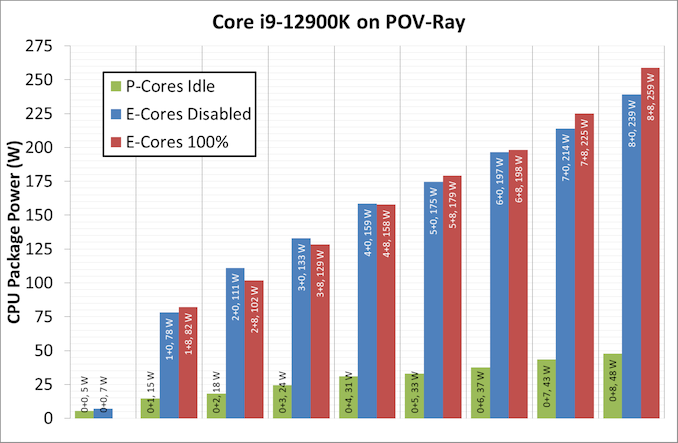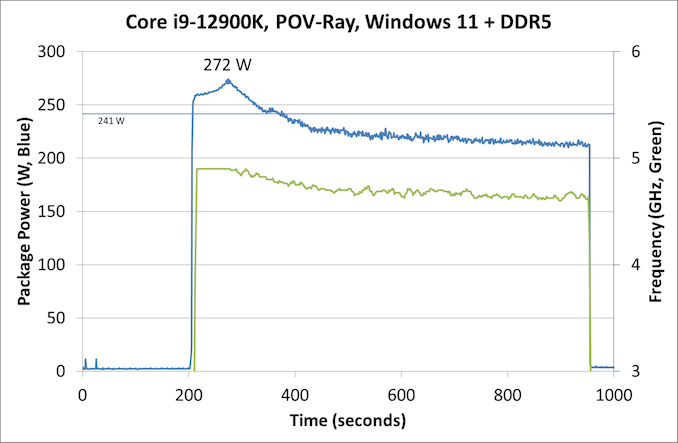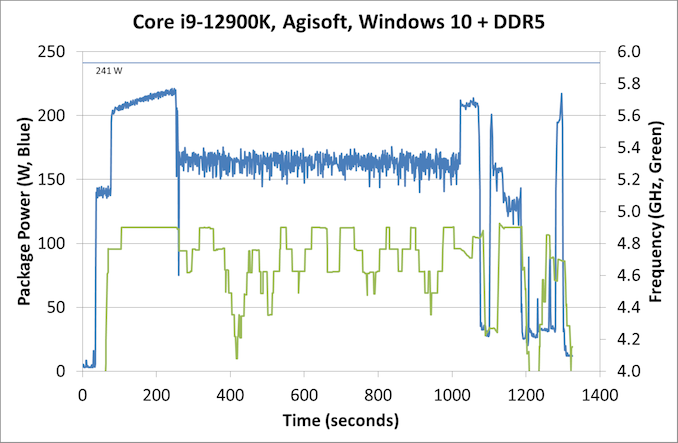The Intel 12th Gen Core i9-12900K Review: Hybrid Performance Brings Hybrid Complexity
by Dr. Ian Cutress & Andrei Frumusanu on November 4, 2021 9:00 AM ESTPower: P-Core vs E-Core, Win10 vs Win11
For Alder Lake, Intel brings two new things into the mix when we start talking about power.
First is what we’ve already talked about, the new P-core and E-core, each with different levels of performance per watt and targeted at different sorts of workloads. While the P-cores are expected to mimic previous generations of Intel processors, the E-cores should offer an interesting look into how low power operation might work on these systems and in future mobile systems.
The second element is how Intel is describing power. Rather than simply quote a ‘TDP’, or Thermal Design Power, Intel has decided (with much rejoicing) to start putting two numbers next to each processor, one for the base processor power and one for maximum turbo processor power, which we’ll call Base and Turbo. The idea is that the Base power mimics the TDP value we had before – it’s the power at which the all-core base frequency is guaranteed to. The Turbo power indicates the highest power level that should be observed in normal power virus (usually defined as something causing 90-95% of the CPU to continually switch) situation. There is usually a weighted time factor that limits how long a processor can remain in its Turbo state for slowly reeling back, but for the K processors Intel has made that time factor effectively infinite – with the right cooling, these processors should be able to use their Turbo power all day, all week, and all year.
So with that in mind, let’s start simply looking at the individual P-cores and E-cores.
Listed in red, in this test, all 8P+8E cores fully loaded (on DDR5), we get a CPU package power of 259 W. The progression from idle to load is steady, although there is a big jump from idle to single core. When one core is loaded, we go from 7 W to 78 W, which is a big 71 W jump. Because this is package power (the output for core power had some issues), this does include firing up the ring, the L3 cache, and the DRAM controller, but even if that makes 20% of the difference, we’re still looking at ~55-60 W enabled for a single core. By comparison, for our single thread SPEC power testing on Linux, we see a more modest 25-30W per core, which we put down to POV-Ray’s instruction density.
By contrast, in green, the E-cores only jump from 5 W to 15 W when a single core is active, and that is the same number as we see on SPEC power testing. Using all the E-cores, at 3.9 GHz, brings the package power up to 48 W total.
It is worth noting that there are differences between the blue bars (P-cores only) and the red bars (all cores, with E-cores loaded all the time), and that sometimes the blue bar consumes more power than the red bar. Our blue bar tests were done with E-cores disabled in the BIOS, which means that there might be more leeway in balancing a workload across a smaller number of cores, allowing for higher power. However as everything ramps up, the advantage swings the other way it seems. It’s a bit odd to see this behavior.
Moving on to individual testing, and here’s a look at a power trace of POV-Ray in Windows 11:
Here we’re seeing a higher spike in power, up to 272 W now, with the system at 4.9 GHz all-core. Interestingly enough, we see a decrease of power through the 241 W Turbo Power limit, and it settles around 225 W, with the reported frequency actually dropping to between 4.7-4.8 GHz instead. Technically this all-core is meant to take into account some of the E-cores, so this might be a case of the workload distributing itself and finding the best performance/power point when it comes to instruction mix, cache mix, and IO requirements. However, it takes a good 3-5 minutes to get there, if that’s the case.
Intrigued by this, I looked at how some of our other tests did between different operating systems. Enter Agisoft:
Between Windows 10 and Windows 11, the traces look near identical. The actual run time was 5 seconds faster on Windows 11 out of 20 minutes, so 0.4% faster, which we would consider run-to-run variation. The peaks and spikes look barely higher in Windows 11, and the frequency trace in Windows 11 looks a little more consistent, but overall they’re practically the same.
For our usual power graphs, we get something like this, and we’ll also add in the AVX-512 numbers from that page:

Compared to Intel’s previous 11th Generation Processor, the Alder Lake Core i9 uses more power during AVX2, but is actually lower in AVX-512. The difficulty of presenting this graph in the future is based on those E-cores; they're more efficient, and as you’ll see in the results later. Even on AVX-512, Alder Lake pulls out a performance lead using 50 W fewer than 11th Gen.
When we compare it to AMD however, with that 142 W PPT limit that AMD has, Intel is often trailing at a 20-70 W deficit when we’re looking at full load efficiency. That being said, Intel is likely going to argue that in mixed workloads, such as two software programs running where something is on the E-cores, it wants to be the more efficient design.














474 Comments
View All Comments
kwohlt - Sunday, November 7, 2021 - link
"Really, the only way I think they can remedy this is by designing a new core from scratch"Intel is designing an entirely new architecture from scratch, according to Moore's Law is Dead leaks. This new architecture design, which started under Jim Keller, is called the "Royal Core Project" and is aimed for a 2025 release. This year also aligns with Gelsinger's recent claims of "We expect Intel to definitively retake the performance crown across the board in 2025"
Whether that actually happens is to be seen, but Pat's specific year target combined with the Moore's Law is Dead leak seem to suggest a whole new architecture is very likely.
GeoffreyA - Monday, November 8, 2021 - link
Looking forward to seeing this. Could it be ARM? I wonder.mode_13h - Monday, November 8, 2021 - link
I wondered that, too. It could be Jim's revenge for the K12 getting canceled!cchi - Friday, November 5, 2021 - link
Jim Keller strikes again?mode_13h - Friday, November 5, 2021 - link
If he had any hand in Alder lake, it was probably at the margins. He arrived too late to have much involvement in the CPU and his role at Intel seems to have been more in the area of new technology development.cchi - Friday, November 5, 2021 - link
https://hardwaresfera.com/en/noticias/hardware/int...Not sure how true this is...
mode_13h - Friday, November 5, 2021 - link
Looks like a 100% clickbait article that's all weakly-inform speculation and zero substance. Go read the two recent interviews with him on this site. He talks about his position within Intel, how far removed he was from any actual work, and how his focus was more on evangelizing within the company.1. https://www.anandtech.com/show/16709/an-interview-...
2. https://www.anandtech.com/show/16762/an-anandtech-...
And, ignoring all of that, it takes 4-5 years to design a CPU and get it shipped. The timelines simply don't match up. Lastly, he was there for under 2 years, which isn't enough time to really learn how a company works and build a strong team.
Even at AMD, where he was for 3+ years, he even refused credit as the father of Zen. And it's a smaller company where he had prior history.
dwade123 - Friday, November 5, 2021 - link
The fact that Alder Lake consumes way less power than Zen 3 during gaming is amazing. This is where it matters the most because nobody will be playing Cinebench 12 hours a day. 5950x wastes a lot of powers for no good reason during gaming. I'm surprised Intel didn't advertise this heavily.mode_13h - Friday, November 5, 2021 - link
> nobody will be playing Cinebench 12 hours a day.Did you ever ask an animator how long their renders take?
adamxpeter - Friday, November 5, 2021 - link
Scroll Lock and Excel mixes well ....